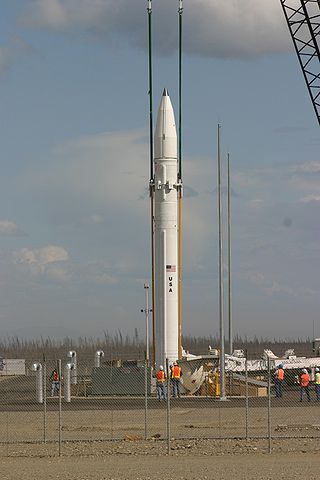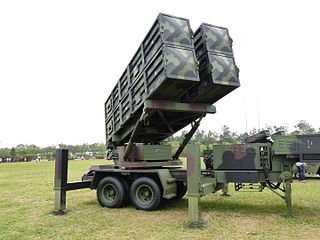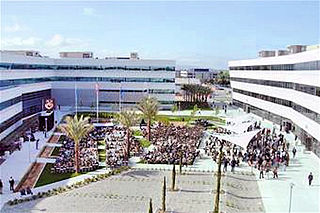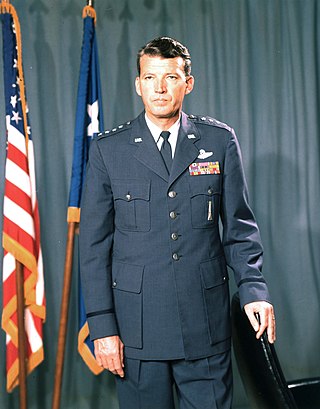
An anti-ballistic missile (ABM) is a surface-to-air missile designed to counter ballistic missiles. Ballistic missiles are used to deliver nuclear, chemical, biological, or conventional warheads in a ballistic flight trajectory. The term "anti-ballistic missile" is a generic term for a system designed to intercept and destroy any type of ballistic threat; however, it is commonly used for systems specifically designed to counter intercontinental ballistic missiles (ICBMs).

The Defense Advanced Research Projects Agency (DARPA) is a research and development agency of the United States Department of Defense responsible for the development of emerging technologies for use by the military. Originally known as the Advanced Research Projects Agency (ARPA), the agency was created on February 7, 1958, by President Dwight D. Eisenhower in response to the Soviet launching of Sputnik 1 in 1957. By collaborating with academia, industry, and government partners, DARPA formulates and executes research and development projects to expand the frontiers of technology and science, often beyond immediate U.S. military requirements. The name of the organization first changed from its founding name, ARPA, to DARPA, in March 1972, changing back to ARPA in February 1993, then reverted to DARPA in March 1996.

Lawrence Livermore National Laboratory (LLNL) is a federally funded research and development center in Livermore, California, United States. Originally established in 1952, the laboratory now is sponsored by the United States Department of Energy and administered privately by Lawrence Livermore National Security, LLC.

Northrop Grumman Corporation is an American multinational aerospace and defense company. With 95,000 employees and an annual revenue in excess of $30 billion, it is one of the world's largest weapons manufacturers and military technology providers. The firm ranked No. 101 on the 2022 Fortune 500 list of America's largest corporations.
Leidos Holdings, Inc. is an American defense, aviation, information technology, and biomedical research company headquartered in Reston, Virginia, that provides scientific, engineering, systems integration, and technical services. Founded as Science Applications International Corporation (SAIC),[6] Leidos merged with Lockheed Martin's IT sector, Information Systems & Global Solutions, in August 2016 to create the defense industry’s largest IT services provider. The Leidos-Lockheed Martin merger is one of the biggest transactions thus far in the consolidation of the defense sector. Leidos contracts extensively with the Department of Defense, the Department of Homeland Security, and the Intelligence Community, as well as other U.S. government agencies and select commercial markets.

The Raytheon Company was a major U.S. defense contractor and industrial corporation with manufacturing concentrations in weapons and military and commercial electronics. Founded in 1922, it merged in 2020 with United Technologies Corporation to form Raytheon Technologies, which changed its name to RTX Corporation in July 2023.

National missile defense (NMD) refers to the nationwide antimissile program the United States has had under development since the 1990s. After the renaming in 2002, the term now refers to the entire program, not just the ground-based interceptors and associated facilities.

AAI Corporation is an aerospace and defense development and manufacturing firm, located in Hunt Valley, Maryland, US. Formerly a wholly owned subsidiary of United Industrial Corporation, AAI was acquired by Textron in 2007. It currently operates as a unit of Textron Systems and employs more than 2,000.

National Chung-Shan Institute of Science and Technology is a Taiwanese state owned corporation, formerly part of the Ministry of National Defense's Armaments Bureau, which is active in the development, manufacturing, support, and sustainment of various weapons systems and dual use technologies.

Los Angeles Air Force Base (LAAFB) is a United States Space Force base located in El Segundo, California. Los Angeles Air Force Base houses and supports the headquarters of the Space Systems Command field command of the United States Space Force, which was established on August 13, 2021. The center manages research, development and acquisition of military space systems.

The AGM-129 ACM was a low-observable, subsonic, turbofan-powered, air-launched cruise missile originally designed and built by General Dynamics and eventually acquired by Raytheon Missile Systems. Prior to its withdrawal from service in 2012, the AGM-129A was carried exclusively by the US Air Force's B-52H Stratofortress bombers.
List of abbreviations, acronyms and initials related to military subjects such as modern armour, artillery, infantry, and weapons, along with their definitions.
ManTech International Corporation is an American defense contracting firm based in Herndon, Virginia. It was co-founded in 1968 by Franc Wertheimer and George J. Pedersen. The company uses technology to help government and industry clients. The company name "ManTech" is a portmanteau formed through the combination of "management" and "technology."

The AGM-158C LRASM is a stealth air launch anti-ship cruise missile developed for the United States Air Force and United States Navy by the Defense Advanced Research Projects Agency (DARPA). Derived from the AGM-158B JASSM-ER, the LRASM was intended to pioneer more sophisticated autonomous targeting capabilities than the U.S. Navy's current Harpoon anti-ship missile, which has been in service since 1977.

TASC, Inc., formerly known as The Analytic Sciences Corporation, is an American private defense contractor based outside Washington, D.C., in Chantilly, Virginia. Northrop Grumman owned TASC from 2001 to 2009, when it sold the unit to comply with new government conflict of interest rules.

Penrose "Parney" C. Albright is an American physicist known for his work with the U.S. Government, think tanks and National Laboratories, and government contractors. Since November 1, 2014, he has been the president and CEO of HRL Laboratories, a research firm jointly owned by Boeing and General Motors. Until December 2013 he served as the director of Lawrence Livermore National Laboratory, and, in 2014, he served as a senior advisor in the Office of the Director of National Intelligence.

The AN/FPQ-16 Perimeter Acquisition Radar Attack Characterization System is a powerful United States Space Force passive electronically scanned array radar system located in North Dakota. It is the second most powerful phased array radar system in the US Space Force's fleet of missile warning and space surveillance systems, behind the more modern PAVE PAWS phased array radar.
Zenith Star was a Directed-energy weapon that started development as part of the US Strategic Defense Initiative.

While the United States Space Force gained its independence on 20 December 2019, the history of the United States Space Force can be traced back to the beginnings of the military space program following the conclusion of the Second World War in 1945. Early military space development was begun within the United States Army Air Forces by General Henry H. Arnold, who identified space as a crucial military arena decades before the first spaceflight. Gaining its independence from the Army on 18 September 1947, the United States Air Force began development of military space and ballistic missile programs, while also competing with the United States Army and United States Navy for the space mission.

Assault Breaker was a Defense Advanced Research Projects Agency (DARPA) program begun in 1978 to integrate a number of technologies including lasers, electro-optical sensors, microelectronics, data processors and radars important for precision guided munitions (PGMs).
















